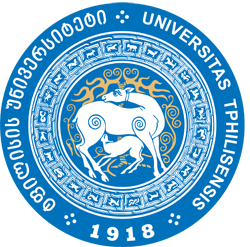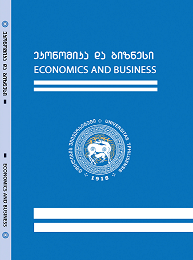
Referential and Reviewed International Scientific-Analytical Journal of Ivane Javakhishvili Tbilisi State University, Faculty of Economics and Business

Primary Health Care Financing Methods in Georgia: Challenges and Prospects
https://doi.org/10.52340/eab.2024.16.01.11
Most of the cases of medical services are performed at the ambulatory-polyclinic level. Outpatient-polyclinic medical services represent the most massive type of services that the majority of the population applies to. Ambulatory-polyclinic medical services, as a rule, begin and end the patient's referral to the health care system, it has significant opportunities for efficient use of financial resources. Therefore, the selection of payment methods for primary care is of particular importance. The following main methods of financing primary health care are used: lump-sum payment method, fixed-salary payment method, fee-for-service method.
In order to promote the development of primary health care in Georgia, it is necessary to pay family doctors and nurses properly. In many countries, the primary health care team is funded by motivation, which means not only stimulating the acceptance of as many patients as possible, but also the quality of the work performed, the detection of diseases at an early stage. Incentive payment methods for doctors to provide preventive measures to beneficiaries are particularly noteworthy. In this regard, the method of financing the doctor is one of the main levers for the effective implementation of health services.
It is advisable to use effective methods of payment for primary care, in particular, the introduction of combined methods, which implies the use of other payment methods (based on services rendered, targeted payment, etc.) in addition to the basic method. This gives an incentive to doctors to expand the range of diagnostic and treatment services, to ensure the continuity of medical care.
Keywords: social financing, primary health care, family doctor, targeted financing.
Capitation refers to the financing of medical staff or a medical facility based on a capitation rate (pay per person) that is fixed and depends on the size of the population it serves.
The positive aspects of voluntary financing are: an increase in competition, as the doctor tries to increase the number of patients registered with him in order to receive a high remuneration; containment of cost growth; ease of settlement; activation of preventive measures; Strengthening the role of the doctor as a "gatekeeper".
The targeted financing method is used to finance certain, specific types of medical care (eg, immunizations, preventive examinations, etc.). The method of targeted financing is mainly used in the provision of large-scale medical services (eg, preventive vaccinations). The doctor is incentivized to administer prophylactic vaccinations to as many patients as possible because he receives additional compensation in case of targeted funding.
The fee-for-service method is financing based on each unit of medical care (procedures performed, diagnostic tests, number of patients treated). The doctor has an incentive to provide the patient with the maximum amount and quality of medical care.
Fixed-salary remuneration is a fixed financing of medical personnel for the performance of general and not specific tasks during an agreed period of time. In case of fixed remuneration, the doctor's income does not depend on the volume of medical care provided.
References:
• Mikava N, Gabrichidze S. (2019). susti pirveladi jandatsva – jandatsvis saqoveltao khelmisatsvdomobis mightsevis mtavari barieri. [Weak Primary Health Care - the Main Barrier to Achieving Universal Access to Health Care. Open Society Foundation of Georgia.] in Georgian
• Verulava T., Beruashvili D. (2019). ojakhis ekimtan mimartvianobis problemebi sakartveloshi. [Problems of Contacting a Family Doctor in Georgia. Health Policy, Economics and Sociology, 3 (1).] in Georgian
• Verulava T. (2023). jandatsvis sistemis miznebi da punktsiebi. [Objectives and Functions of the Health Care System. Health Policy, Economics and Sociology, 7 (2).] in Georgian
• Verulava T., Chiladze G., Barkalaya T. (2022). pirveli jandatsvis personalis mushaoba da samushao momsakhureobis gamotsveva sakartveloshi [Challenges of Primary Health Care Staff Motivation and Job Satisfaction in Georgia. Economist. 3.] in Georgian
• Verulava T., Jorbenadze A. (2022). pirveli jandatsvis repormirebis 1995-2003 tslebis teknika da dizaini. [1995-2003 Experience and Recommendations of Reforming Primary Health Care. Economist, 2:23-41.] in Georgian
• Jorbenadze A., Verulava T. (2021). diagnoztan shechiduli jgupit (DRG) saavadmqopos pinansuri metodi da 1995 tslis jandatsvis repormebi. [The Diagnosis-Restricted Group (DRG) Method of Hospital Financing and the 1995 Health Care Reforms. Economist, XVII (4): 31-41.] in Georgian
• Verulava T., Jorbenadze R. (2020). pirveli jandatsvis mekaribcheoba da mimartvianoba: patsientebis tvalsazrisis ojakhis ekimis rolze. [Gatekeeping and Referral in Primary Care: Patients' Perspectives on the Role of the Family Physician. Economics and business. 12 (1).] in Georgian
• Verulava T. (2018). pirveli jandatsvis gamotsvevebi sakartveloshi. [Primary Health Care Challenges in Georgia. Globalization and business. University of Europe. (5): 259-262.] in Georgian
• Vardukadze M., Verulava T. (2023). sapensio asakis pirebis khelmisatsvdomoba gadaudebel onko-hematologiur momsakhureobaze DRG modelis danergvis shemdeg. [Financial Access of Pensioners to Urgent Onco-hematological Services After the Implementation of the DRG Model. Health Policy, Economics and Sociology, 7(2).] in Georgian
• Abashidze G. (2023). ojakhis ekimis sistemis ganvitareba taivanshi. [The Development of the Family Physician System in Taiwan. Health Policy, Economics and Sociology, 6.] in Georgian
• Mikiashvili G., Verulava T. (2021). jandatsvis sistemis repormebi: turketis magaliti. [Successful Reforms of the Health Care System: the Example of Turkey. Health Policy, Economics and Sociology, 5.] in Georgian
• Verulava T. (2023). Barriers to Effective Communication between Family Physicians and Patients in Georgia. Family Medicine & Primary Care Review 25(1): 80–85
• Verulava T., Jorbenadze A. (2022). Primary Health care Reforms in Georgia: the Experience and Challenges. Arch Balk Med Union. 57(4):384-389.
• Verulava T., Jorbenadze R., Karimi L. (2020). Patients’ Perceptions about Access to Health Care and Referrals to Family Physicians in Georgia. Archives of the Balkan Medical Union. 55(4): 642-650.
• Verulava T. (2022). Factors Influencing Medical Students’ Choice of Family Medicine. Family Medicine & Primary Care Review. 24(1):66-70
• Langenbrunner JC and Wiley MM. (2002). “Hospital Payment Mechanisms: Theory and Practice in Transition Countries,” Chapter 8 in McKee, M. and Healy, J., eds., Hospitals in a Changing Europe (Buckingham, UK: Open University Press,).
• Gerdtham UG, Søgaard J, et al. (1992). A Pooled Cross Section Analysis of the Health Care Expenditures of the OECD Countries. In P. Zweifel & H. E. Frech, eds. Health Economics Worldwide. Boston: Kluwer Academic Publishers: Dordrecht, The Netherlands, 287-310.
Keywords: Social financing, primary health care, family doctor, targeted financing.
JEL Codes: H51, I11, I18, P36









